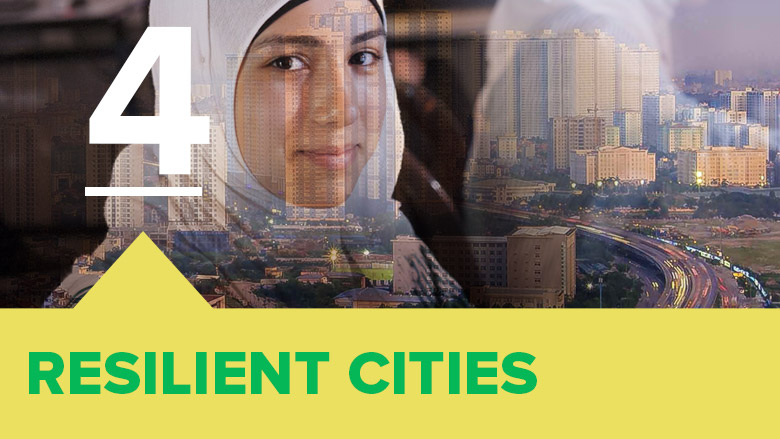Challenge and Opportunity
Unprecedented urbanization is transforming the planet and the way we live. For the first time in history, more people live in cities than in rural areas. Today, 3.9 billion people live in urban areas, and the urban population is expected to grow by another 2.5 billion people by 2050. 90% of this growth is predicted to take place in Africa and Asia.
If done right, the cities of tomorrow can be places where people enjoy healthy, active, productive lives; reducing climate impacts and ensuring resilience; and acting as engines of economic growth, generating opportunity and wealth for the whole country. But today, too much urban expansion occurs near natural hazards, along rivers and coastlines, and through informal and unplanned settlements. Lack of adequate infrastructure, land use planning and building codes exacerbate the risks to which urban dwellers are exposed. And a greater concentration of people and assets means that the impact of natural disasters and a changing climate can be devastating in lives lost and livelihoods destroyed. The poorest people are always the most vulnerable.
Investing in climate-resilient infrastructure is at the heart of ensuring livable, inclusive, and economically dynamic cities. But less than 20% of the largest 500 cities in developing countries are deemed creditworthy in their local context, severely constricting their capacity to finance investments in public infrastructure. In some developing countries, the market is not yet sufficiently developed to enable the flow of capital into urban infrastructure projects. Many cities need support to make the most of their existing assets and apply risk-mitigating and capital enhancing mechanisms. And despite strong investment interest in emerging market infrastructure, perceived risk, a lack of well-prepared projects and high transaction costs can inhibit deployment of capital.
The World Bank Group is working to overcome these challenges. For example, in the city of Can Tho in Vietnam, a package of investments across six development sectors is helping increase the city’s physical, financial and social resilience to extreme climate events. And, as part of its financial and advisory services to cities in more than 60 countries, the International Finance Corporation (IFC) committed a $50 million loan to support the development of a low-emission, climate-resilient urban transportation system under the City of Buenos Aires, Argentina Urban Transformation Project. The project supports new efficient bus lines and new infrastructure for bicycle transportation.
Transformative Action
The City Resilience Program (CRP), supported by the Global Facility for Disaster Reduction and Recovery, assists city governments to build resilience to climate and disaster risks by connecting them to the technical expertise and the finance they need. The program facilitates strategic investments that address the vulnerabilities and risks faced by cities. Through a transparent pipeline of well-prepared and bankable investment opportunities, the program enables private and institutional investors to enter new markets.
Specifically, CRP advises cities on ways to access capital through direct lending, public private partnerships, and strategic use of land assets. The program catalyzes deal flows for investors by supporting city governments in the design of large-scale investments. The focus is on reducing transaction costs, including through building governments’ capacity to move towards investment readiness, and facilitating negotiations between cities and investors. Bringing in financial advisors as well as local and international investors creates an effective ecosystem for city resilience financing. And by bringing private sector solutions to the table, the program also seeks to maximize the leverage of every dollar invested by the public sector.
Expected Results
CRP has catalyzed or contributed to seven investment projects totaling almost $1 billion. In the medium to long-term, CRP is supporting the development of a transparent pipeline of climate-smart investment opportunities. It will create a marketplace that connects cities and investors. Since its launch in June 2017, CRP has engaged with nearly 50 cities and is expected to scale up to over 500 cities within 10 years.
Key Facts & Figures:
- In recent years, the World Bank has worked in cities and towns across over 140 countries, investing $5.3 billion in disaster risk management during fiscal year 2018.
- With its innovative tools and powerful financing products and services, the WBG is helping the urban poor and boosting resilience at the household, community, city, and regional levels.
- IFC’s Cities Initiative focuses on addressing the financing gap for sustainable urban infrastructure by providing and attracting commercial financing to the sector. In the last 10 years, IFC invested more than $12 billion in over 350 urban improvement projects and provided advisory services to cities in more than 60 countries.
Last Updated: Jan 24, 2019
